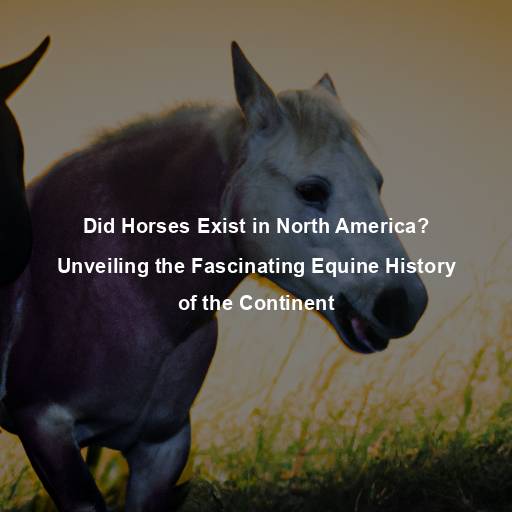Where Do Horses Evolve From?
Last Updated on November 5, 2023 by Evan
Contents
- 1 The Origins of Horses: A Journey Through Time
- 1.1 The Dawn of Equine History
- 1.2 The Eohippus: A Tiny Wonder
- 1.3 Evolutionary Adaptations: The Journey Towards Modern Horses
- 1.4 The Expansion of Horses: From North America to the World
- 1.5 The Modern Equine Family Tree
- 1.6 Preserving the Legacy: The Importance of Horse Conservation
- 1.7 Genetic Diversity: A Window into the Past
- 1.8 The Przewalski’s Horse: A Living Relic
- 1.9 The Role of Selective Breeding
- 1.10 Genetic Disorders: Challenges and Solutions
- 2 The Bond Between Humans and Horses: A Tale of Friendship
- 3 Horses in Contemporary Society: Challenges and Advocacy
- 4 A Timeless Connection: The Enduring Legacy of Horses
- 5 FAQs: Where do horses evolve from
The Origins of Horses: A Journey Through Time
Step into the enigmatic world of equine history and embark on a mesmerizing voyage, where the enigmatic origins of horses are unveiled. Delve into the captivating narrative that unravels the remarkable transformation of these iconic creatures, from their humble beginnings to the embodiment of grace and power they are today. Prepare to be captivated by a tale that transcends time, filled with mysterious twists and turns that will leave you in awe of the captivating evolution of horses. Join us as we embark on this unprecedented odyssey through the annals of equine history.
The Dawn of Equine History
Journeying back through the annals of time, we find ourselves immersed in the enigmatic era known as the Eocene epoch, a staggering 56 million years ago. During this captivating period, an intriguing cast of equestrian pioneers emerged – the eohippus, colloquially known as the “dawn horse”. These diminutive creatures, akin in size to our loyal canine companions, treaded delicately amidst the verdant expanse of North America’s resplendent forests, their origins shrouded in captivating mystery.
The Eohippus: A Tiny Wonder
The eohippus, known by its awe-inducing alias, Hyracotherium, was truly a marvel of existence. This fascinating creature, standing a mere 12-20 inches in height, boasted a plethora of unique attributes that distinguished it from its modern-day equine counterparts. With its compact physique and an intriguing number of digits, this ancestor of the majestic horse lineage defied convention by flaunting four toes on its forelimbs and three on its hind limbs. This dexterity granted the eohippus the ability to gracefully maneuver through dense thickets and verdant foliage, leaving onlookers perplexed and amazed.
Evolutionary Adaptations: The Journey Towards Modern Horses
Throughout countless millennia, the eohippus embarked on an extraordinary journey of transformation, as the ceaseless march of time unveiled an array of evolutionary adaptations that would ultimately shape the majestic horses we now behold. Against the backdrop of a shifting environment and the relentless drive for survival, these magnificent creatures deftly navigated the labyrinth of existence, embracing the winds of change and sculpting their very essence to ensure their continued dominion. With each successive adaptation, the eohippus etched its indelible mark upon the annals of history, weaving a tapestry of mystery and wonder that echoes through the ages.
The Transition to Grasslands
In the fascinating realm of evolutionary history, the equestrian journey unfolds with captivating astonishment. Amidst the shifting climate, as lush forests transformed into sprawling grasslands, horses found themselves caught in a perplexing dance with nature. With an indomitable spirit, they embarked on a transformative odyssey, embracing elongated limbs that bestowed upon them the power to gracefully traverse vast distances, seeking sustenance from the bountiful grasses that now adorned their realm. As if in defiance of convention, their toes underwent a mystical metamorphosis, shedding their multiplicity to embrace a singular identity, converging towards a harmonious embodiment of equine elegance.
Increase in Body Size
Throughout the course of their evolution, horses experienced an astonishing metamorphosis, marked notably by a remarkable surge in their stature. As these majestic creatures embraced the sprawling grasslands, their bodies expanded in size and grandeur, facilitating enhanced swiftness and fortitude. In the face of lurking dangers, this expansion enabled them to outmaneuver predators, all while effortlessly traversing great expanses in search of sustenance. An enigmatic journey of growth and adaptation, truly befitting the magnificence of these equine marvels.
Dental Adaptations
Throughout the ages, the remarkable evolutionary journey of horses has encompassed many awe-inspiring adaptations. One such adaptation that captivates the mind is the transformation of their teeth. As these majestic creatures embraced a verdant diet rich in grass, their pearly whites underwent a mesmerizing metamorphosis, elongating and sprouting intricate ridges. This enchanting dental revolution enabled them to masterfully conquer the demanding task of masticating the tougher grasses that thrived in their new home.
Strengthened Limbs and Hooves
As the world around them evolved, horses weren’t left behind. In a remarkable adaptation, their limbs underwent a stunning transformation, emerging as powerful and elongated appendages. This newfound strength propelled them to unimaginable speeds, an exhilarating escape from the clutches of their pursuers. And that’s not all – their hooves, once vulnerable, solidified into an invincible shield, granting them the ability to conquer any obstacle that nature could throw their way.
The Expansion of Horses: From North America to the World
The captivating journey of horses from the vast grasslands of North America to the far reaches of our planet is a tale woven with enigmatic threads of migration, human influence, and the mystifying forces of nature. These majestic creatures, with their unmatched ability to thrive in diverse climates and conquer unforgiving terrains, defied all odds to become the ubiquitous beings we know today. Embarking on a tumultuous adventure, their relentless pursuit for new horizons and uncharted lands bestowed upon them the distinguished title of one of the most prevalent and awe-inspiring mammals on our perplexing Earth.
Migration and Natural Dispersal
Throughout the eons, a captivating dance between land and horse unraveled, leading to a mesmerizing tapestry of migration across continents. Daringly traversing land bridges and boldly venturing into unknown territories, these majestic creatures embarked on a quest for sustenance, ideal environments, and the enchanting call of companionship. Across vast spans of time, their hoofprints imprinted an epic saga of exploration, resilience, and adaptation that unraveled the mysteries of Eurasia, Africa, and eventually even beyond to the enchanting lands of South America.
Human Involvement
The expansion of horses was further facilitated by human involvement. Humans recognized the value of horses as companions and tools for transportation, agriculture, and warfare. Through domestication, selective breeding, and transportation, humans played a crucial role in the dispersal and diversification of horses across the globe.
The Modern Equine Family Tree
Today, the equine family tree is diverse, encompassing various species and breeds. From the sturdy draft horses to the agile Arabians and the elegant Thoroughbreds, each breed carries a unique set of characteristics that have been shaped by centuries of selective breeding and human intervention.
Preserving the Legacy: The Importance of Horse Conservation
As we marvel at the evolutionary journey of horses, it is vital to recognize the ongoing need for horse conservation. Many horse species are currently endangered or threatened due to habitat loss, human encroachment, and other factors. Preserving their genetic diversity and natural habitats is crucial for the long-term survival of these magnificent creatures.
Genetic Diversity: A Window into the Past
Delving into the fascinating world of equine genetics offers a mesmerizing glimpse into the intricate tapestry of horse ancestry, illuminating the perplexing connections that bind diverse populations. Through meticulous examination of the equine DNA mosaic, diligent scientists have unlocked genetic markers that offer tantalizing clues about the enigmatic origins and historical migrations of these majestic creatures. Embark on a captivating journey through time as we unravel the secrets encoded in the equine genome, painting a vivid portrait of the untold stories hidden within horse breeds.
The Przewalski’s Horse: A Living Relic
It’s truly mind-boggling how horse genetics have unveiled an enthralling connection between our domesticated four-legged friends and the Przewalski’s horse, an extraordinary wild species dwelling in Central Asia. Deeper exploration into their genetic blueprint has astonishingly revealed that the Przewalski’s horse holds the title of being the closest living kin to the ancient wild horse bloodline, from which our beloved domesticated horses can trace their roots. This revelation has left experts and enthusiasts alike puzzled, as the intricate tapestry of equine ancestry unfolds before our eyes.
The Role of Selective Breeding
Throughout the ages, mankind has engaged in the intricate art of selective breeding, an ancient practice that has undeniably left an indelible mark on the captivating world of horses. This delicate dance of choosing and pairing horses with exquisite traits has artfully sculpted the genetic tapestry of various equine breeds, bequeathing us with a bewildering array of majestic creatures that grace our landscapes today. In this mesmerizing interplay of human ingenuity and nature’s whimsy, the magnificent equine kingdom has evolved, each breed a testament to the enigmatic power of selective breeding.
Genetic Disorders: Challenges and Solutions
Throughout the journey of selective breeding, remarkable horse breeds have emerged, showcasing extraordinary prowess. However, nestled within this tapestry of uniqueness, lies an enigmatic twist. Hidden within the genetic code are disorders like equine polysaccharide storage myopathy (EPSM) or hyperkalemic periodic paralysis (HYPP), veiled adversaries that plague certain breeds. A steadfast resolve has arisen from this conundrum, as scientists endeavor to unravel the complexities, devising genetic testing methods and breeding strategies, fostering a future where equine welfare and vigor reign supreme.
The Bond Between Humans and Horses: A Tale of Friendship
For millennia, humans and horses have shared an inexplicable bond, woven tightly through the tapestry of history. In this intricate relationship, triumph and hardship have danced, leaving us spellbound by the immense tapestry of emotions that have unfolded. No longer confined to their roles as mere beasts of burden, horses have transcended their physical form and nestled themselves within the deepest crevices of our hearts, offering solace, camaraderie, and even healing. Such is the enigmatic power of these majestic creatures, forever entwined with our own existence.
Horses in History: A Symbol of Power and Mobility
In the tapestry of human existence, few creatures have woven themselves so intricately as the horse. Through the labyrinth of time, these majestic beings have been our loyal companions, deftly navigating the vast terrain of our civilization. Their indomitable strength, nimble swiftness, and graceful prowess have left an indelible mark on our collective consciousness. With their hooves pounding against the earth, horses have carried us through battles, plowed our fields, and galloped into an era of boundless possibilities.
Horses in Sport: From Racing to Show Jumping
The athletic prowess and grace of horses have made them a natural fit for various equestrian sports. Whether it’s the thundering hooves on the racetrack or the precision jumps in show jumping, horses have captivated audiences and showcased their incredible abilities. The deep bond between riders and their horses is evident in the trust and partnership required to excel in these disciplines.
Equine-Assisted Therapy: Healing Hooves
Discover the enchanting world where horses transcend their gentle physicality, connecting with humans in a way that defies understanding. Through the incredible practice of equine-assisted therapy, these majestic creatures become conduits of healing, guiding individuals through physical, emotional, and psychological hurdles. Amidst the perplexing magic of the horse-human bond, the mere act of tending to these majestic beings sparks a transformation, empowering individuals as they embark on a journey of self-discovery and personal growth. Step into this burst of enchantment, where the presence of horses becomes a catalyst for resilience and renewal.
Horses in Contemporary Society: Challenges and Advocacy
While horses continue to hold a special place in our hearts, they face numerous challenges in the modern world. From welfare concerns to conservation efforts, there is a growing need for advocacy and responsible stewardship to ensure the well-being and preservation of these magnificent creatures.
Equine Welfare: Promoting Ethical Practices
As our understanding of horse welfare evolves, there is an increasing emphasis on promoting ethical practices in horse care. This includes providing proper nutrition, appropriate housing, and ensuring access to veterinary care. Organizations and individuals dedicated to equine welfare work tirelessly to raise awareness, enforce regulations, and advocate for the humane treatment of horses in all contexts.
Preserving Natural Habitats: A Call for Conservation
In a world where human footprints seem to creep into every corner of nature’s domain, the plight of wild horses becomes a heart-wrenching narrative of loss and uncertainty. These majestic creatures find themselves at the mercy of our encroaching presence, feeling the weight of our activities bear down on their once untouched habitats. Yet, pockets of hope sprout amidst the chaos, as dedicated individuals strive to shield these resilient beings from harm’s reach and facilitate the revival of their ancestral landscapes. Balancing on the precipice of survival, wild horses hold the key to preserving the delicate equilibrium of our natural world – a weighty responsibility that forces us to confront the consequences of our actions and work towards a harmonious coexistence.
Responsible Ownership and Breeding Practices
Responsible horse ownership and breeding practices are crucial for maintaining the long-term health and welfare of horses. This includes thoughtful breeding decisions to preserve genetic diversity, responsible horse acquisition and care, and prioritizing the well-being of horses throughout their lives.
Education and Advocacy: Inspiring Change
Raising awareness and educating the public about the importance of horses is vital for their continued well-being and conservation. By fostering a deeper appreciation for horses and their contributions to our lives, we can inspire action and support initiatives that safeguard their future.
A Timeless Connection: The Enduring Legacy of Horses
As we delve into the intricate tapestry of our shared history, an enigmatic thread emerges – the intricate relationship between humans and horses. From their unassuming origins as creatures inhabiting verdant woodlands to their metamorphosis into companions, athletes, and healers, horses have etched their presence onto the very fabric of our existence. Their allure persists, entrancing and igniting our hearts with an inexplicable force. In their galloping strides, we find a captivating saga of inspiration and fascination.
As we navigate the challenges of the modern world, it is our responsibility to ensure the welfare, conservation, and ethical treatment of horses. By celebrating their legacy, advocating for their well-being, and fostering a deep respect for these magnificent creatures, we can honor their timeless connection with humanity and ensure that horses thrive for generations to come.
FAQs: Where do horses evolve from
What is the evolutionary origin of horses?
Step into the enigmatic world of Equus caballus, where the astonishing tale of evolution unfurls in a captivating dance of time and adaptation. Peer back through the veils of millennia to a distant epoch when the modern-day horse was but a whisper in the winds of existence. Meet Eohippus, a diminutive companion from the past, a creature no larger than man’s loyal four-legged friend, with uncanny resemblances to the majestic equine beings we know today. Marvel at nature’s enigmatic brushstrokes, as Eohippus leaves its hoofprints on the sands of eternity, forever shaping the tapestry of equine evolution.
How did horses evolve over time?
The evolution of horses can be traced through a series of fossil records. From Eohippus, several transitional species such as Mesohippus, Merychippus, and Pliohippus emerged. These species gradually grew larger in size and developed adaptations that allowed them to exploit different habitats. Notably, they underwent changes in their teeth structure, skull shape, limb proportions, and the development of a single toe-like structure, known as the hoof.
Where did the evolution of horses primarily occur?
The mesmerizing story of horse evolution takes us on a captivating journey through the untamed wilderness of North America. Fossil remnants, whispering secrets from the past, unveil a tale of horses blossoming against the backdrop of lush forests and expansive grasslands. In a dance of adaptation and survival, these majestic creatures embraced the changing climate and thrived in new habitats. Yet, as nature’s enigmatic hand dealt its cards, the horse’s reign in North America came to an abrupt halt, only to be reignited by the intrepid Europeans who carried their hooved companions across the seas during the era of colonization.
Were horses always the size they are today?
No, horses have undergone significant size changes throughout their evolutionary history. The earliest ancestors, like Eohippus, were relatively small animals about the size of a fox terrier. Over time, as they adapted to different ecological niches and changing environments, horses gradually increased in size. This process is known as phyletic size increase. The modern-day horses we are familiar with reached their current size during the last few million years.
How do we know about the evolution of horses?
Unlocking the enigmatic journey of horse evolution has been a dazzling feat, driven by the tireless efforts of paleontologists and the treasures they’ve unearthed from the depths of time. Laden with ancient tales, these fossils serve as portholes to a bygone era, spiraling our imagination into uncharted territories. With a discerning eye, scientists delve deep into the intricate patterns of morphological transformations, skillfully assembling the puzzle pieces of equine ancestry to unveil the majestic timeline of their evolution. The enigmatic voyage of these noble creatures continues to enthrall and perplex, leaving us in awe of the winding road they’ve traveled.
Are there any living relatives of horses?
Yes, horses belong to the family Equidae, which includes other living species and subspecies of Equus. Some of the living relatives of horses include zebras and donkeys. These animals share a common ancestor and demonstrate similar anatomical and genetic characteristics. Although horses have been domesticated by humans for thousands of years, their wild counterparts can still be found in certain regions, preserving the evolutionary lineage of these magnificent creatures.







